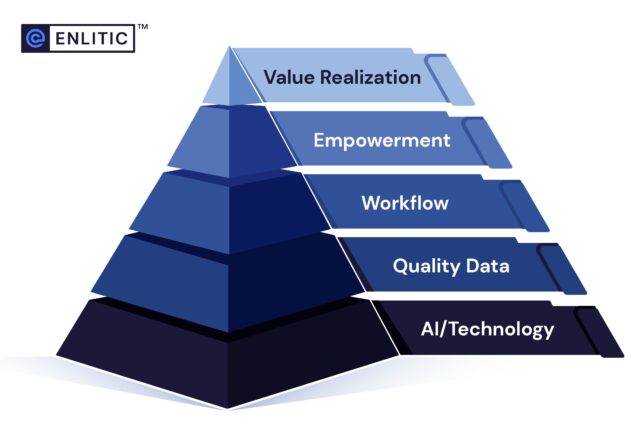 In today’s rapidly evolving healthcare landscape, leveraging technology to enhance operational efficiency and patient outcomes is paramount. One conceptual model that helps healthcare providers systematically realize value from their technological investments is the Value Realization Pyramid. This framework outlines how high-quality data, generated by advanced technologies like Artificial Intelligence (AI), can drive enterprise-wide workflows and empower executives to make informed decisions. Let’s delve into how this pyramid operates and why it’s crucial for the modern healthcare provider.
In today’s rapidly evolving healthcare landscape, leveraging technology to enhance operational efficiency and patient outcomes is paramount. One conceptual model that helps healthcare providers systematically realize value from their technological investments is the Value Realization Pyramid. This framework outlines how high-quality data, generated by advanced technologies like Artificial Intelligence (AI), can drive enterprise-wide workflows and empower executives to make informed decisions. Let’s delve into how this pyramid operates and why it’s crucial for the modern healthcare provider.
The Foundation: High-Quality Data
At the base of the Value Realization Pyramid lies high-quality data. AI plays a pivotal role in this foundational layer by ensuring the data’s correctness, consistency, and completeness. For instance:
- Correctness: AI algorithms can ensure that laterality is correct, that typos are fixed and that the study is correctly labeled as to the absence or presence of contrast.
- Completeness: AI can fill in missing values, such as descriptions for MR localizers or other missing fields that facilities want to leverage.
- Consistency: AI enhances data by ensuring that studies with the same parameters are labeled the same, enabling many enterprise benefits
Data drives many functions within a hospital and high-quality data is critical. The desire for higher data utilization is a common theme, however 97% of that data still remains unused. Data standardization of medical images would be the first step for ensuring high-quality data.
The Middle Tier: Driving Workflows
Once high-quality data is established, the next tier of the pyramid focuses on driving workflows throughout the healthcare enterprise. Efficient workflows are essential for optimizing operations, reducing costs, and improving patient care. Here’s how high-quality data informs and streamlines workflows:
- Radiology Reporting: AI-driven data can improve many steps required to make the reporting process efficient. Standardized data will ensure that worklists are accurate, prior studies are properly prefetched, data is routed to the correct post processing station and hanging protocols and dictation templates are relevant to the study being reported.
- Operational Efficiency: Understanding the data is key to becoming more operationally in tune. Standardized data can help analysis determine accurate results and drive efficiencies such as optimizing imaging schedules, assessing risk or routing data to the correct after hours credentialled radiologist.
- Data Sharing: Data can assist researchers, disease registries and help develop strategic relationships with pharmaceutical and clinical trial companies.
By automating routine tasks and providing actionable insights, AI-driven workflows free up healthcare professionals to focus on what they do best: caring for patients.
The Apex: Empowering Executives
At the pinnacle of the Value Realization Pyramid is the objective of empowering executives. For healthcare executives, the ability to make data-driven decisions is critical to achieving strategic goals and maintaining a competitive edge. High-quality data and streamlined workflows converge to provide a robust decision-making framework. Here’s how:
- Strategic Planning: Executives can use comprehensive data analytics to identify trends, forecast future needs, and develop long-term strategic plans. For example, understanding patient demographics and disease prevalence can guide investments in new services or technologies.
- Performance Measurement: Data-driven metrics allow executives to monitor performance across different departments and identify areas for improvement. This can include patient satisfaction scores, treatment outcomes, and financial performance.
- Regulatory Compliance and Risk Management: Accurate and comprehensive data ensures that the organization adheres to regulatory requirements and can effectively manage risks. AI can help detect and mitigate compliance issues before they become significant problems.
Realizing Value from Medical Imaging Data
A critical aspect of realizing value in healthcare is through the effective use of medical imaging data. Medical imaging, including X-rays, CT scans, MRIs, and ultrasounds, generates vast amounts of data that, if properly harnessed, can provide profound insights into patient health and treatment efficacy.
Conclusion
The Value Realization Pyramid provides a strategic framework for healthcare providers to unlock the full potential of their technological investments. By ensuring high-quality data, driving efficient workflows, and empowering executives with actionable insights, healthcare organizations can enhance patient care, optimize operations, and achieve their strategic goals. In particular, the effective use of AI and medical imaging data exemplifies how advanced technology can transform healthcare, providing a clear path to realizing substantial value.
As healthcare continues to evolve, embracing this data-driven approach will be crucial for providers aiming to deliver high-quality care while navigating the complexities of the modern healthcare environment.
SUMMARY
The Value Realization Pyramid is designed to help healthcare providers derive value from their technological investments by leveraging high-quality data. It emphasizes standardized data driving efficient workflows enterprise-wide. Executives are empowered to make data-driven decisions and can optimize operations and achieve strategic goals.

